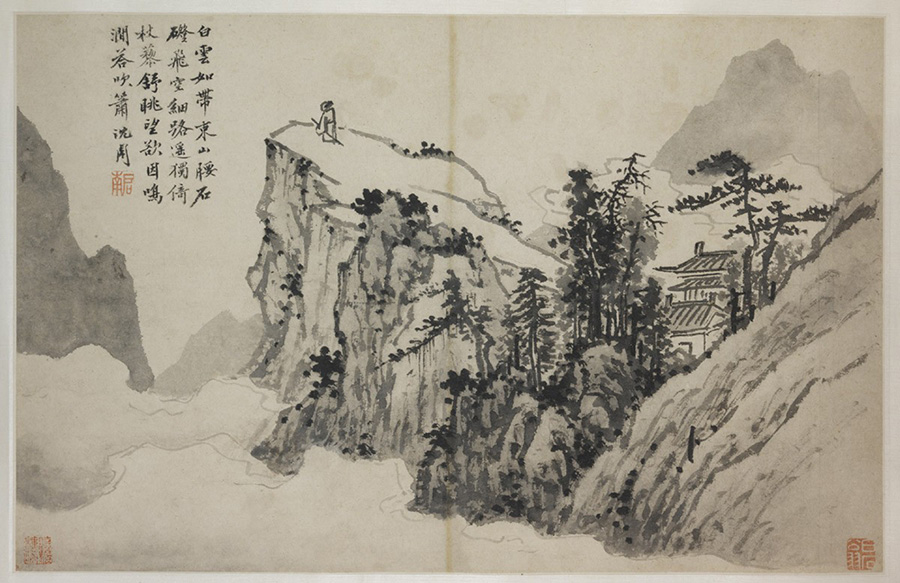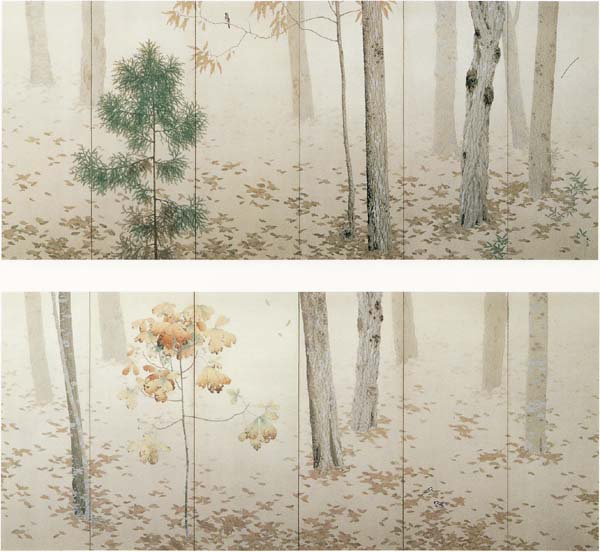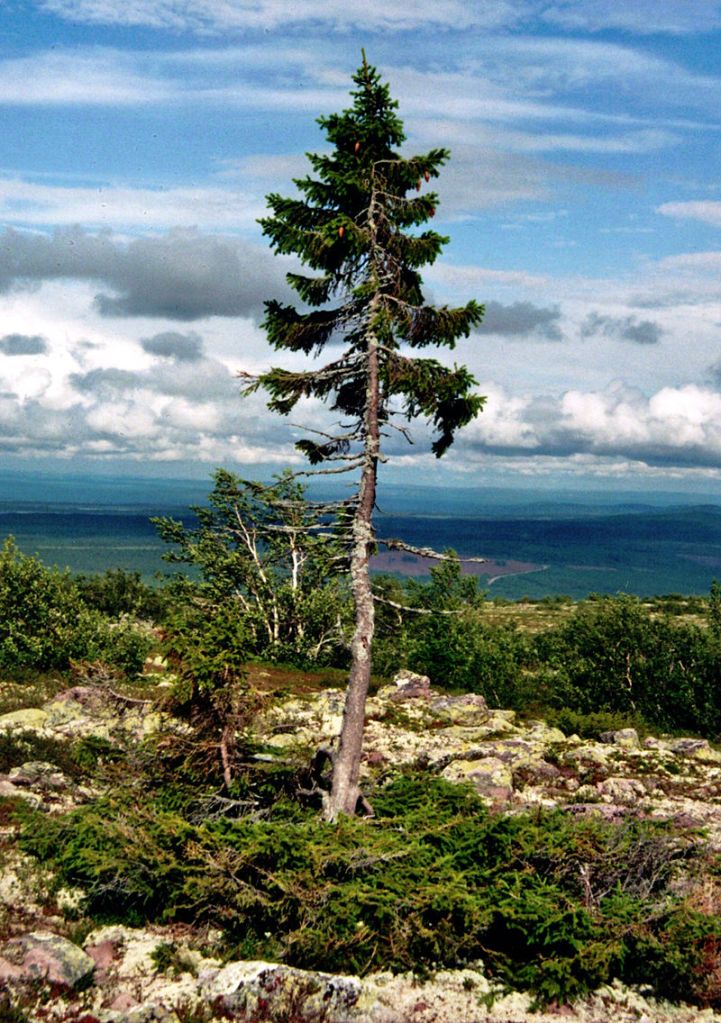While listening to a talk of Alan Watts recently, I was struck by one of his observations. He said that in Daoist inspired landscape painting was a statement against anthropocentrism, which sees humans as the crown of creation. In a painting “Poet on a Mountaintop” by Shen Zhou, a fifteenth-century Chinese painter inspired by Daoism, the human figure does not dominate the landscape, as it was frequently the case in Western painting. The tiny figure of the poet is at first hard to spot because he stands in total harmony with his surroundings.

Yet even in Western thought there are some voices strongly challenging anthropocentrism. One of them is that of Olafur Eliasson, an Icelandic-Danish artist, who recently came to Switzerland with an exhibition called Life. By removing the windows of the exhibition pavilion and flooding the building with water he symbolically erased the boundaries that we try to erect to keep the nature out of the spaces we inhabit. In a write-up to the exhibition we can read:
“… the enclosure of the Beyeler Foundation building by Renzo Piano has been partially removed to let ‘the world’ enter into the museum. What is usually kept out – water, plants, and animals – breaks through and invades the world of humans.”
https://www.inexhibit.com/…/in-olafur-eliassons-life…/
“To realize that human life is inextricably entangled with that of all the creatures around us makes us aware of our vulnerability and that we all share a common fate, thus subverting the anthropocentric perspective we have had for centuries.”
https://olafureliasson.net/archive/exhibition/EXH102547/life

At the museum’s bookshop I picked up a book by a philosopher Emanuele Coccia entitled The Life of Plants: A Metaphysics of Mixture. First of all, it is worth pointing out that he is one of very few philosophers who occupies himself with contemplating nature. Otherwise this is not a subject worthy of today’s philosophers’ interests. Furthermore, the academic world does not tolerate mixing of disciplines. However, as Coccia points out,
“Things and ideas are much less disciplined than people: they mix among themselves without worrying about taboos or etiquette; they circulate freely without waiting for permission; …
Ideas mix together in a way that is “not mediated by any discipline and by any norm and that has no other base than a blind, disorganized, undiscerning desire,” he adds and states:
“In the sea of thought, everything communicates with everything and every kind of knowledge is penetrated by all the others.”

True philosophy is simply the love of knowledge and love falls under the domain of Eros, who, as Coccia puts it, was “the most undisciplined and rugged of all gods.”
To me his book reads as a hymn to plant life. Plants are not mere decorations on the tree of life, Coccia affirms. On the contrary, nothing would exist without them. He quotes Karl L. Niklas, who said, “This is a blue planet, but it is a green world.”
In the first part of the book he focuses on the ontological status of plants. Since they do not run or fly, they always remain where they are. Thus they are “pure observers,” who “embody the most direct and elementary connection that life can establish with the world.” They are one with the world since they totally melt into the environment. The most astounding quality that they have is naturally that of creating life:
“They transform everything they touch into life, they make out of matter, air, and sunlight what, for the rest of the living, will be a space of habitation, a world.
…
The life of plants is a cosmogony in action, the constant genesis of our cosmos.”

I was particularly inspired by Coccia’s reflections on the meaning of breath. It reminded me of the concept of prana in the Upanishads, where we can read:
“For all these beings merge into breath alone, and from breath they arise.” (2)
All life comes from water but at some point it left the primordial sea and settled on firm earth. Plants were the first to see that process through. Coccia states that through photosynthesis “plants have transformed the world into the reality of breath” and the world is nothing else but “the breath of the living.” Though life came out of the water, it has never abandoned “the fluid space” that we are all immersed in:
“Terra firma is just the extreme limit of this cosmic fluid at the heart of which everything communicates, touches, extends.”

Plants help us recognize that the whole world is “a space of immersion.” Stable boundaries are just an illusion. According to Coccia, the totality of life exists in the “atmosphere,” or “the sphere of breath.” Breath creates unity and intimacy between all the cosmic elements. Importantly, this mixture exists without erasing the individual identities of its components. There is no reduction of variety.
Breath is much more than air, says Coccia. He equates it with the Logos understood as language, reason and “lightning, unveiling, means of revelation.” It is the Logos which allows the elements to mix without losing their individual essence. Breath is what creates unity between “the animal and the cosmos.” As the fish are immersed in the sea, so do we “inhabit the air through the atmosphere.” The world exists within all its beings, which means that “every being is capable of radically transforming the world.” There is unity pervading the cosmos and life is always inclusive.
Another fascinating section of the book is dedicated to the significance of roots, “the most enigmatic forms of the plant world”:
“The roots make the soil and the subterranean world a space of spiritual communication. Thanks to them, then, the most solid part of the Earth is transformed into an enormous planetary brain through which matter circulates, along with information on the identity and state of the organisms that populate the surrounding environment. It is as if the eternal night, in which one imagines the depths of the Earth to be plunged, were anything but a long and deaf sleep. In the immense and silent horn of the underground, night is a perception without organs, without eyes and without ears, a perception that takes place through the whole body. Intelligence, thanks to roots, exists in mineral form, in a world without sun and without movement.”

Although we humans do not have physical roots, I could not help thinking that Coccia’s description of roots is reminiscent of Jung’s concept of the unconscious. Our lives above ground are rooted in the dark sphere of the unconscious psyche and also in the dark wisdom of our bodies.
I was also moved by Coccia’s understanding of what the origin of life is. He argues that:
“The origin of our world does not reside in an event that is infinitely distant from us in time and space, millions of light years away; nor does it reside in a space of which we no longer have a trace. It is here and now. The origin of the world is seasonal, rhythmic, deciduous like everything that exists.
…
The origin of our world is in leaves: fragile, vulnerable, yet capable of returning, of coming back to life once they have passed through the rough season.”

Each moment in the river of time can result in the creation of new life. The wisdom of the breath constantly renews the cosmos. Life is also something that endures underground, in the sphere of roots. In his new book called The Heartbeat of Trees, Peter Wohlleben, a German forester and author of the bestselling The Hidden Life of Trees, (3) writes about his visit with the famous Old Tjikko – a 9550-year-old spruce located in Sweden:
“For a moment I was speechless as I thought about how long this tiny scrawny tree had held out up here. Almost ten thousand years had passed since it germinated from its seed. Mammoths had died out, Stonehenge had been erected, and the pyramids had been built. The climate had fluctuated from cold to warm and back again multiple times, but, unaffected by any of this, the spruce was still standing intact today in the place where it had been born. … This means that the ‘tree’ we see today is only a few hundred years old. The true old spruce is to be found in the roots and in the brushy growth covering the ground. As I looked at the tree, I once again asked myself what really makes a tree a tree. Is it the trunk, which we usually think of as being the most important part? Or is it the roots, which have survived for thousands of years and are where the old spruce has probably stored all that it remembers? At the moment, I’m tending toward the latter. Visually, the spruce is nothing special; it’s all about its history. Its attraction lies in simply knowing that it has been fighting for its life for 9,550 years and may possibly survive for a few thousand more.”


Support my blog
If you appreciate my writing, consider donating to support my work. Thank you very much in advance.
$1.00
Notes:
(1) https://symbolreader.net/2019/09/13/beauty-and-wonder-in-olafur-eliassons-art/
(2) The Chandogya Upanishad, First Prapathaka, eleventh Khanda, via https://www.hinduwebsite.com/sacredscripts/hinduism/upanishads/chandogya.asp#Pra7
(3) I wrote about this book here: https://symbolreader.net/2016/10/22/the-holiness-of-trees/












Lovely post Monika with striking images. Have you heard about Animist philosophy?
Here is a link: https://en.wikipedia.org/wiki/Animism#:~:text=Animism%20(from%20Latin%3A%20anima%2C,words%E2%80%94as%20animated%20and%20alive.
hugs, Linda
LikeLiked by 1 person
Thank you very much, Linda. Yes, I strongly believe in animism, Anima Mundi, etc. I still identify with Anne of Green Gables 😊
LikeLiked by 2 people